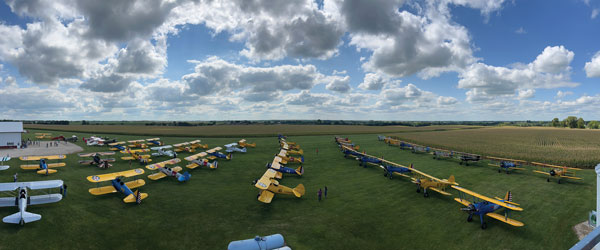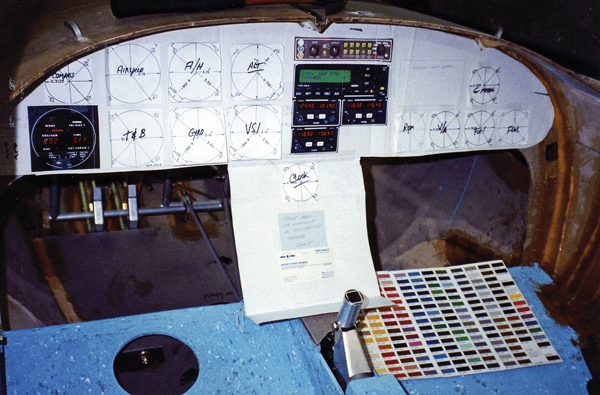By Robert N. Rossier, EAA 472091
This piece originally ran in Robert’s Stick and Rudder column in the December 2023 issue of EAA Sport Aviation magazine.
Lately I’ve had the opportunity to ponder the effects of high altitude on human physiology. As pilots, we have a good idea about how high-density altitude affects the performance characteristics of our airplane. But it might be that we overlook the similarities of our own performance as the air we breathe begins to thin.
We all know that the atmosphere consists of roughly 21 percent oxygen, and that percentage remains constant as we ascend to higher altitudes. The total atmospheric pressure decreases with altitude, and with that comes a decrease in the partial pressure of oxygen. That means less driving force is available to move oxygen across the tissues of our lungs and into the bloodstream. At some point, as we ascend, the reduction in oxygen partial pressure catches up with us and begins to affect our physiological functions — a condition known as hypoxic hypoxia.
Years back, I had the opportunity to undergo high altitude chamber testing to learn firsthand about the effects of hypoxic hypoxia. As an experienced mountain flying instructor and mountain climber, I figured I had a leg up on those who had not experienced the effects of diminished oxygen availability firsthand. I was wrong. As I quickly learned, hypoxia can sneak up on us with little or no warning, and the attendant impairment can be severe.
Physiological Factors
A number of factors can determine when and how an individual will experience hypoxia. Age, physical condition, fatigue, acclimatization to altitude, medications, and individual genetics are among the factors affecting hypoxia, as well as the environment and the type of work in which an individual is engaged.
For most individuals, the effects of even a 1 to 2 percent reduction in the ambient oxygen level can be noticed. With so many contribution factors in play, what might be no problem at all on one day could spell disaster on another.
Symptoms of Hypoxia
Consider for a moment how altitude affects our nonturbocharged, piston-powered aircraft engine. Power output decreases by roughly 3 percent for every 1,000 feet of density altitude. At 7,000 feet, power is decreased by 21 percent. At 10,000 feet, power is decreased by 30 percent.
Could it be that our own performance — mental or physical — also experiences a radical reduction at altitude?
In fact, such is the case. While the symptoms of hypoxia and their onset can vary significantly from one individual to another, numerous medical sources outline the common symptoms of hypoxia, which include the following:
- Increased breathing and heart rate — the human body naturally reacts to reduced oxygen levels by increasing the respiration rate and heart rate.
- Headaches — lack of oxygen often results in headaches, especially in response to increased physical activity.
- Lightheadedness — exposure to reduced oxygen levels can cause light headedness and the inability to focus or concentrate.
- Additional sensations — these can include dizziness, tingling, warm sensations, feelings of euphoria, sweating, and difficulty breathing.
- Visual impairment — low oxygen levels can result in tunnel vision. Loss of visual acuity at night can occur at altitudes as low as 5,000 MSL.
- Impaired physical and mental abilities — symptoms include poor motor coordination, slow reaction times, loss of situational awareness, confusion, impaired judgment, and the inability to perform even simple calculations.
Not long ago, a pilot explained to me just how hypoxia can sneak up on us. The pilot was on a cross-country night flight in the western United States and had briefly climbed to altitude to cross over high terrain.
After being handed off to another controller to continue flight following, the pilot was asked to confirm altitude. Looking at the altimeter, the pilot only recognized a jumble of numbers that could not be deciphered.
“I should be at 7,500 feet,” the pilot responded, trying to maintain composure while puzzling out the situation. The pilot could see the altimeter, was not experiencing a vision problem, but was just confused. A short while later, the pilot requested a descent to 5,000 feet, after which the confusion subsided and did not again arise.
The most jarring aspect of this anecdote is that the impairment that comes with hypoxia isn’t recognized as it develops. We never see it coming. There we are, flying along, carrying out our normal routine, and everything is fine — until suddenly it isn’t.
Regulations on the Use of Supplemental Oxygen
According to FAR 91.211, pilots are required to use supplemental oxygen for that part of a flight at altitudes from 12,500 to 14,000 MSL that exceed durations more than 30 minutes. Above 14,000 MSL, pilots must have and use supplemental oxygen during the entire time at those altitudes.
Above 15,000 MSL, each occupant must be provided with supplemental oxygen.
However, following these requirements does not guarantee that we will not be adversely affected by the reduced oxygen, even at lower altitudes. In fact, other sources may suggest where hypoxia problems could arise for us as pilots.
The Occupational Safety and Health Administration (OSHA) requires atmospheric oxygen levels in the work environment to be between 19.5 to 23.5 percent (at sea level), noting a “safe zone” between 19.5 and 16 percent. It notes that impairment of mental functions can occur at oxygen levels from 14 to 10 percent. At oxygen levels of 10 to 12 percent, respiration increases and lips turn blue. Between 8 and 10 percent oxygen levels, individuals will experience fainting and unconsciousness. At 6 percent oxygen, death will occur in a mere eight minutes.
Let’s put that in perspective for flying. At an altitude of 7,000 feet, the partial pressure of oxygen corresponds to 16 percent at sea level, putting us at the bottom of OSHA’s “safe zone.” At higher altitudes, we can easily dip into the range of mental impairment. At 10,000 MSL, the equivalent oxygen percentage is nearing 14 percent — the range in which mental impairment becomes an issue.
Again, the onset of specific effects of hypoxia will vary from one individual to another, from one day to another, and from one situation to another. With these figures in mind, it’s no surprise that the pilot on that night flight could experience confusion when trying to decipher an altimeter reading while flying at 7,500 feet MSL. In fact, any of us could experience such an event, and the result could be a particularly bad day.
A Simple Solution
While the onset of hypoxia may not be immediately obvious to us as pilots, the relief of those symptoms is almost immediate when supplemental oxygen is used. For nonpressurized aircraft, portable oxygen supplies, delivery systems, and masks or nasal cannulas can be used to enrich the air we breathe at altitude, and allow us to maintain a clear head.
Let’s remember that high altitudes really can bring us high risks. Hypoxia can easily sneak up and disable us before we even think to remedy the problem. Our best bet might be to steer clear of situations (altitudes and times) where hypoxic hypoxia can impair us, and give ourselves a margin of safety — just in case it isn’t our best day. Any time we venture into the thin air of high altitudes, we may want to hedge our bets by having and using supplemental oxygen.
Robert N. Rossier, EAA 472091, has been flying for more than 40 years and has worked as a flight instructor, commercial pilot, chief pilot, and FAA flight check airman
Post Comments




